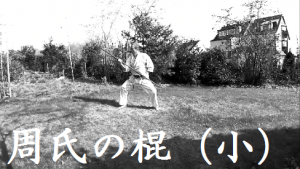When searching Youtube for “Shushi no Kon Sho”, there are literally hundreds of search results where people perform this kata. You should really try it NOW and watch some of the examples first.
It is clear they belong to various schools, as can be seen in all the varying habits displayed during performances. However, it is impossible to judge the technical specifics of other schools – simply because how can you know the reasons for it?
Well, there is the saying that the hip must be used and this is constantly heard of on Okinawa, too. The use of hip is laborious and takes time to develop. It is also a bit different to empty-handed hip work. To make matters worse, it is simply not necessary to incorporate hip work when using a relatively light bō: the arms will easily do the job.
However, when using a heavier bō, working on one’s hip work seems to be the only way to provide for correct technique. When avoiding it, for example by regular training with light bō, or the wish for speed, the actual complex technique is cut short and becomes a shunning movement instead. We see this everywhere. Even on Okinawa the emphasis on impressing and speedy performance seems to have sparked a fashion of shunning the intended and defined technique. I do it too every now and then. And I know the reason is laziness and the urge to deliver an impressive performance. To be honest: who wants to look lame?
But having been forced to use the hips from the start, for me it is rather normal. An observation I made in Okinawa, is that for some reason everybody talks about the necessity of hip usage, but rarely you see people actually doing it. Maybe it is invisible. Especially men for some reason do not do it, while some of the ladies do it very good, however without that ever being recognized. I think guys are just stiff, or they are ashamed, or they think it’s unmanly, or they simply don’t care and rely on their brute force of their arms and their scowl performance face. This said, the use of the hip often seemed to me to be a bit of paying lip service. Anyway, think of the hip usage as a manual gearshift (I know most of you drive automatic):
- take out gear
- kick down clutch pedal
- put in required gear
- release clutch pedal until gear engages
- and only now: hit the gas
There is also the opposite end to the use of the hip, namely the use of disjointed “bio-mechanical principles” that end up like representing something of a forced, robotic motion.
Another point is application! People tend to think of striking and thrusting as the main technical conception of bōjutsu. What if there are actually sophisticated techniques in the kata that include tied weapons, similar to kakie? And what if with a heavy bō you need to move behind the bō to generate proper power and control, rather than poking here and there into the air? And what if in bōjutsu always both sides of the bō are used to engage? These are just some thoughts. In Shūshi no Kon Shō, for example, you should view the first technique as hooking between the opponents weapon and arm and pulling him in; the strike is just an extra.

Shushi no Kon Sho (snapshot).
There are several types of Shūshi no Kon. In Taira lineage kobudō a Shō and a Dai version have been handed down, which are most commonly seen. In the Taira→Inoue lineage there was also handed down a Shūshi no Kon Chū. The same kata is called Koryū Shūshi no Kon in Taira→Akamine lineage, but is not part of the official syllabus. This is an older form of this kata that originated in the teachings of Yamane-ryū and trace back to 1920s teachings of Chinen Sanda and Ōshiro Chōjo, who taught the village youth of the Kakazu area in Tomigusuku. In Matayoshi kobudō it is called Shūshi no Kon without further distinction, but actually this is Shūshi no Kon Dai and there can be little doubt that it entered Matayoshi kobudō via Taira Shinken’s teachings. In addition, in Yamane-ryū there is another version from the same provenance, referred to as Sūji no Kon.
Just so you know: I practiced all of them under expert instruction, some more, some less.
The characteristics of Shūshi no Kon Shō are three times rushing forward with a downward strike, vertical block (tate-uke) and others.
 Westerners should be very careful when attempting to teach or to instruct others. Claiming to know and can do something is a double-edged sword. Usually I don’t openly discuss technical questions of karate and kobudō and I dissuade people from doing so. It is simply assumptive. Everyone must perform the way they are taught, follow the rules of their respective schools, and do not discuss the perceived functions or meanings or whatever of others schools’ techniques. You simply cannot know the reasons why it is done this way or that way. Period. Notwithstanding, here are some points that might be useful:
Westerners should be very careful when attempting to teach or to instruct others. Claiming to know and can do something is a double-edged sword. Usually I don’t openly discuss technical questions of karate and kobudō and I dissuade people from doing so. It is simply assumptive. Everyone must perform the way they are taught, follow the rules of their respective schools, and do not discuss the perceived functions or meanings or whatever of others schools’ techniques. You simply cannot know the reasons why it is done this way or that way. Period. Notwithstanding, here are some points that might be useful:
- When bowing, the bō remains in its position and doesn’t move down and up with the body.
- There is no artificial breathing to be done in this kata with each or any specific techniques.
- The armpits stay closed: no oarsmanship.
- The techniques of the bō come from a momentum generated by combined action of stance, hips, upper body, and arms; the hands and arms, however, mostly only guide the direction of the bō while determining its starting and ending positions.
- Kiai is a selectively timed eruption of physical power, a both generated and a generating factor of the performance that is otherwise maintained continuously throughout the kata, but held back except for the moment of kiai. It is not ripping open one’s jaws like a tiger and bellowing.
- When rolling up the bō at the beginning and end of the kata, always roll it to the front to show proper zanshin – i.e. maintained attention and readiness towards the opponent (maybe he is not dead yet? 😉 ).
As can be seen here: points to remember are as many and as different as there are practitioners.
In any case: when watching the evolution of techniques and habits in any school over the decades, it is obvious that things change all the time. Nothing actually constitutes an absolute term in sense of a constant and in and around the enbusen of a kata at any point in time certain concepts might be applied or not, maintained or rejected, for a logical reason or without. Tradition simply does not equal function. Except when function becomes the sole defined and integral part of a tradition, which is a rather narrow perspective I simply cannot see in Okinawa kobudō, although it is often the sole definition of many Westerners. Hasty hasty, become martial arts master soon. Just don’t forget to bring the money.
In the following video I attempt to show some of the hip usage adressed in this article. I am aware that my skills are rather average. However, you may try it out next time when doing the kata. It might add some power to your performance. The kata here is performed with a 1.82m iron wood heavy duty bō. No chance handling it by using the arms only.
If you ever handled a 70″ steel pinch point pry bar you know what this fels like. I certainly did.
© 2015, Andreas Quast. All rights reserved.
